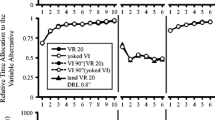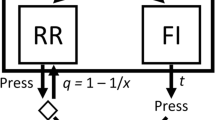Abstract
Three rats responded under concurrent variable-interval schedules of food reinforcement. One schedule component provided reinforcement for the manipulation of an omnidirectional rod; the other schedule component provided reinforcement for pressing a lever. The same force was required to execute each response. Reinforcement rates provided by the schedules were varied over experimental conditions. Allocation of both responses and time between schedules undermatched the ratios of reinforcements obtained from the schedules for each rat. All rats displayed bias in favor of the lever with both response and time allocation, but no consistent difference in the magnitude of bias with response-based versus time-based measures of choice was observed. Previous research on choice between topographically different responses revealed substantially greater bias in response-based measures of choice than in time-based measures. However, response topography has been confounded with response force in previous research. Findings of the present study, in which force requirements for the two responses were equal, indicate that differences in response topography do not necessarily produce differences between response-based and time-based measures of bias. Rather, these findings suggest that differences in measures of bias may result from different force requirements of the responses.
Similar content being viewed by others
References
BAUM, W. M. (1974). On two types of deviation from the matching law: Bias and undermatching. Journal of the Experimental Analysis of Behavior, 22, 231–242.
BAUM, W. M. (1979). Matching, undermatching, and overmatching in studies of choice. Journal of the Experimental Analysis of Behavior, 32, 269–281.
BAUM, W. M., & RACHLIN, H. C. (1969). Choice as time allocation. Journal of the Experimental Analysis of Behavior, 12, 861–874.
BROWNSTEIN, A. J., & PLISKOFF, S. S. (1968). Some effects of relative reinforcement rate and changeover delay in response-independent concurrent schedules of reinforcement. Journal of the Experimental Analysis of Behavior, 11, 683–688.
CATANIA, A. C., & REYNOLDS, G. S. (1968). A quantitative analysis of the responding maintained by interval schedules of reinforcement. Journal of the Experimental Analysis of Behavior, 11, 327–383.
CHUNG, S. (1965). Effects of effort on response rate. Journal of the Experimental Analysis of Behavior, 8, 1–7.
DAVISON, M., & FERGUSON, A. (1978). The effects of different component response requirements in multiple and concurrent schedules. Journal of the Experimental Analysis of Behavior, 29, 283–295.
DAVISON, M. C., & HUNTER, I. W. (1976). Performance on variable-interval schedules arranged singly and concurrently. Journal of the Experimental Analysis of Behavior, 25, 335–345.
de VILLIERS, P. (1977). Choice in concurrent schedules and a quantitative formulation of the law of effect. In W. K. HONIG & J. E. R. STADDON (Eds.), Handbook of operant behavior (pp. 233–287). Englewood Cliffs, NJ: Prentice-Hall.
de VILLIERS, P., & HERRNSTEIN, R. J. (1976). Toward a law of response strength. Psychological Bulletin, 83, 1131–1153.
FERSTER, C. B., & SKINNER, B. F. (1957). Schedules of reinforcement. New York: Appleton-Century-Crofts.
HERRNSTEIN, R. J. (1961). Relative and absolute strength of response as a function of frequency of reinforcement. Journal of the Experimental Analysis of Behavior, 4, 267–272.
HERRNSTEIN, R. J. (1970). On the law of effect. Journal of the Experimental Analysis of Behavior, 13, 243–266.
HUNTER, I. W., & DAVISON, M. C. (1978). Response rate and changeover performance on concurrent variable-interval schedules. Journal of the Experimental Analysis of Behavior, 29, 535–556.
LABOUNTY, C. E., & REYNOLDS, G. S. (1973). An analysis of response and time matching to reinforcement in concurrent ratio-interval schedules. Journal of the Experimental Analysis of Behavior, 19, 155–166.
LOBB, B., & DAVISON, M. C. (1975). Performance in concurrent interval schedules: A systematic replication. Journal of the Experimental Analysis of Behavior, 24, 191–197.
MCSWEENEY, F. K. (1978). Prediction of concurrent keypeck treadle-press responding from simple schedule performance. Animal Learning and Behavior, 6, 444–450.
MYERS, D. L., & MYERS, L. E. (1977). Undermatching: A reappraisal of performance on concurrent variable-interval schedules of reinforcement. Journal of the Experimental Analysis of Behavior, 27, 203–214.
NEVIN, J. A. (1971). Rates and patterns of responding with concurrent fixed-interval and variable-interval reinforcement. Journal of the Experimental Analysis of Behavior, 16, 241–247.
RACHLIN, H. (1973). Contrast and matching. Psychological Review, 80, 217–234.
RIDER, D. P. (1979). Concurrent ratio schedules: Fixed vs. variable response requirements. Journal of the Experimental Analysis of Behavior, 31, 225–237.
RIDER, D. P. (1981). Concurrent fixed-interval variable-ratio schedules and the matching relation. Journal of the Experimental Analysis of Behavior, 36, 317–328.
SHULL, R. L., & PLISKOFF, S. S. (1967). Changeover delay and concurrent schedules: Some effects on relative performance measures. Journal of the Experimental Analysis of Behavior, 10, 517–527.
TAYLOR, R., & DAVISON, M. (1983). Sensitivity to reinforcement in concurrent arithmetic and exponential schedules. Journal of the Experimental Analysis of Behavior, 39, 191–198.
TREVETT, A. J., DAVISON, M. C., & WILLIAMS, R. J. (1972). Performance in concurrent interval schedules. Journal of the Experimental Analysis of Behavior, 17, 369–374.
WHEATLEY, K. L., & ENGBERG, L. A. (1978). Choice performance in several concurrent key-peck treadle-press reinforcement schedules. Journal of the Experimental Analysis of Behavior, 29, 181–190.
WHITE, J. M. (1979). Bias and undermatching in concurrent chain-pull bar-press performance. The Psychological Record, 29, 103–109.
Author information
Authors and Affiliations
Additional information
Funds for this research were provided in part by the Bureau of Child Research and the Department of Human Development, The University of Kansas. I thank Frances K. McSweeney for supplying additional data and analyses from McSweeney (1978) and for helpful comments on an earlier version of this manuscript. I am grateful to Donald M. Baer for advice and assistance with the analysis of data, James A. Sherman for advice and equipment, Dana McMurray for art and graphics, and Joyce O’Neil for assistance in preparing the manuscript.
Rights and permissions
About this article
Cite this article
Rider, D.P. Concurrent Reinforcement of Topographically Different Responses and the Matching Relation. Psychol Rec 35, 377–390 (1985). https://doi.org/10.1007/BF03395859
Published:
Issue Date:
DOI: https://doi.org/10.1007/BF03395859




